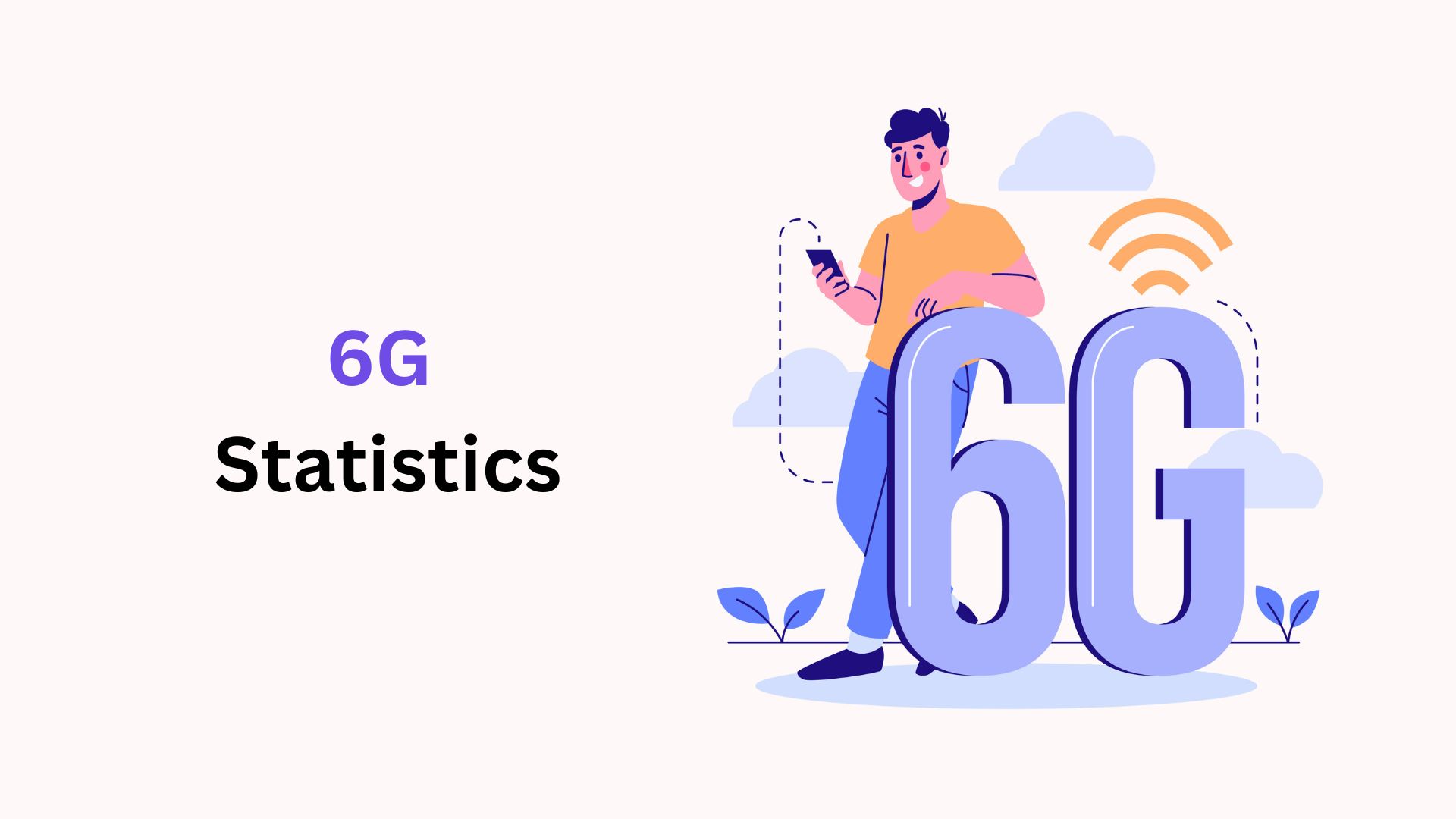Top 10 Most Expensive Coffee In The World (2025)
Updated · Nov 10, 2025

Table of Contents
- Introduction
- Historical Analysis of Coffee
- Coffee Market Size Analysis
- Coffee Bean Varieties
- Type of Coffee
- Coffee Beans and Their Common Uses
- What Affects the Price of Coffee
- Top 10 Most Expensive Coffees of 2025
- #1. Kopi Luwak
- #2. Kona Coffee
- #3. Blue Mountain Coffee
- #4. Geisha Coffee
- #5. Black Ivory Coffee
- #6. Yemeni Coffee
- #7. Monkey Coffee
- #8. Bat Poop Coffee
- #9. Jacu Bird Coffee
- #10. Misha Coffee
- Conclusion
Introduction
Top 10 Most Expensive Coffees: Coffee is loved and preferred globally, but a few rare types are expensive and truly unique. The top 10 most expensive coffees are not just drinks but luxury experiences. These special beans grow in remote or volcanic areas and are carefully processed by skilled farmers using unique, time-consuming methods that enhance their flavor. Each cup of coffee shares a different story of hard work, tradition, and perfection.
Due to their limited harvests, rare plant varieties, and detailed preparation, their prices can reach hundreds or even thousands of dollars per pound. Tasting these exclusive coffees gives people a chance to enjoy a mix of flavor, culture, and rarity like no other.
Historical Analysis of Coffee
- Ethiopian beginnings: A herder named Kaldi reportedly noticed lively goats after eating coffee cherries around 850 AD.
- To Yemen: By the 15th century, people on the Arabian Peninsula were growing and trading coffee.
- Into Europe: 17th-century travellers carried coffee from the Middle East, and coffeehouses spread across Europe.
- New World expansion: In the 18th century, coffee reached the Caribbean and South America; Brazil soon rose as a powerhouse.
- Top producers (2022): Brazil accounted for nearly 29% of the global supply, while Vietnam accounted for around 18%.
- Livelihoods: 20+ million families rely on coffee farming worldwide.
- Consumption: The United States drinks about 400 million cups daily, the most overall.
- Prices: In 2024, bad weather in major producers like Brazil and Vietnam pushed coffee costs toward 50-year highs.
Coffee Market Size Analysis
- Coherent Market Insights report shows that the global coffee market is estimated to capture a revenue of around USD 145.84 million by the end of 2025.
- The overall market growth will reach a CAGR of 4.72% from 2025 to 2032, resulting in USD 201.41 million by 2032.
- A National Coffee Association survey found that over 70% of people prefer making coffee at home.
By Region

- In 2025, Europe leads the global coffee market with a 35.58% share, followed by North America at 23.24%.
- Meanwhile, Asia-Pacific holds 17.65%, and the Middle East & Africa account for 13.33%.
- Lastly, South America, despite being a major producer, captured 10.20% of the consumption share.
By Segment
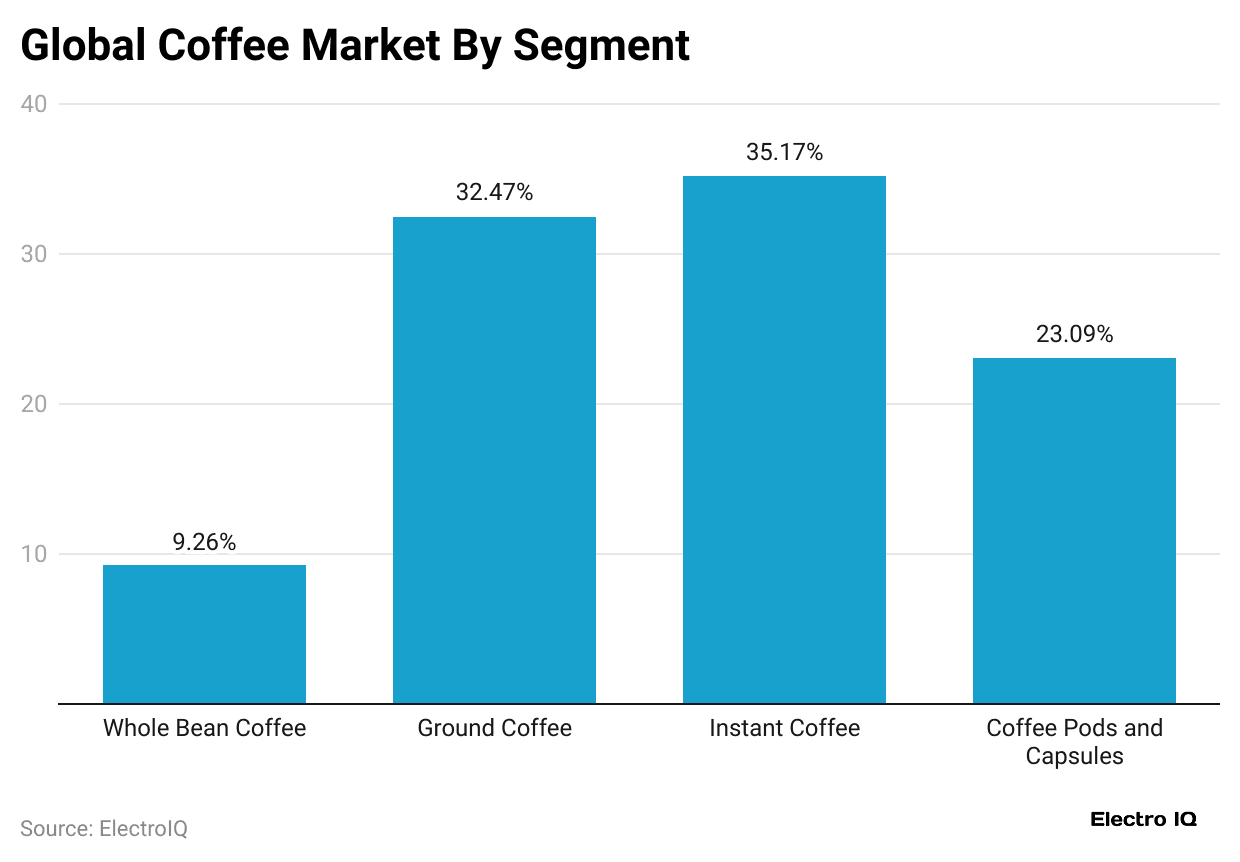
- In 2025, instant coffee leads the global market with a 35.17% share, and ground coffee follows at 32.47%.
- Coffee pods and capsules capture 23.09%, while whole bean coffee accounts for 9.26%.
Coffee Bean Varieties
| Coffee Bean Type | Description |
| Arabica | Smooth, mild flavor; the most widely grown coffee bean. |
| Robusta | Strong and bitter taste with higher caffeine content. |
| Liberica | Rare bean with a fruity, floral aroma and full body. |
| Excelsa | Tart and complex flavor; a subtype of Liberica. |
| Geisha (Gesha) | Premium Arabica known for floral, tea-like taste. |
| Bourbon | Sweet, balanced, and rich-bodied Arabica variety. |
| Typica | Classic smooth Arabica with a well-rounded flavor. |
| Caturra | Bright and citrusy; a mutation of Bourbon. |
| Maragogipe | Very large “Elephant Bean” with mild flavor. |
| Catuai | Hybrid of Mundo Novo and Caturra, popular in Latin America. |
Type of Coffee
| Coffee Drink | Description |
| Espresso | Strong, concentrated shot of coffee. |
| Americano | Espresso mixed with hot water for a milder taste. |
| Latte | Espresso with steamed milk and a thin foam layer. |
| Cappuccino | Espresso topped with equal parts milk and foam. |
| Macchiato | Espresso “stained” with a small amount of milk. |
| Mocha | Espresso blended with chocolate and steamed milk. |
| Flat White | Creamy coffee with microfoam milk and bold espresso. |
| Cortado | Equal parts espresso and warm milk for balanced taste. |
| Ristretto | Shorter, stronger shot of espresso. |
| Cold Brew | Coffee steeped in cold water for 12–24 hours. |
| Iced Coffee | Regular brewed coffee served cold over ice. |
| Turkish Coffee | Finely ground coffee simmered with sugar, unfiltered. |
| French Press | Coffee steeped in hot water and pressed with a plunger. |
| Pour-Over | Hot water slowly poured over coffee grounds for clarity. |
| Affogato | Espresso poured over a scoop of vanilla ice cream. |
Coffee Beans and Their Common Uses
| Coffee Bean Type | Common Drinks Made From It | Description |
| Arabica | Latte, Cappuccino, Americano, Pour-Over | Known for smooth and mild flavor; most popular bean worldwide. |
| Robusta | Espresso, Ristretto, Iced Coffee, Instant Coffee | Strong and bitter taste with high caffeine; adds crema and strength. |
| Liberica | Black Coffee, French Press, Cold Brew | Rare bean with fruity and floral notes; full-bodied and aromatic. |
| Excelsa | Blends, Pour-Over, Cold Brew | Offers tart, complex flavor that adds depth to coffee blends. |
| Geisha (Gesha) | Specialty Pour-Over, Filter Coffee | Premium Arabica variety with delicate, tea-like and floral taste. |
| Bourbon | Espresso, Flat White, Macchiato | Sweet and balanced Arabica type with rich body and pleasant aroma. |
| Typica | Espresso, Americano, Latte | Classic Arabica with balanced acidity and smooth texture. |
| Caturra | Cappuccino, Cortado, Pour-Over | Bright and citrusy flavor; popular for its clean, crisp cup. |
| Maragogipe | French Press, Drip Coffee | Extra-large bean (“Elephant Bean”) with mild and light profile. |
| Catuai | Espresso, Latte, Iced Coffee | Hybrid bean with mild sweetness; popular in Latin America. |
What Affects the Price of Coffee
- Coffee prices change because coffee is an agricultural product traded on the world market.
- The cost of paying workers has a big impact on how much coffee costs.
- Processing the coffee beans after harvest also adds to the total price.
- Shipping and transportation costs play a role since coffee often travels long distances to reach consumers.
- Climate change is another major reason for price increases because it makes growing coffee more difficult.
- Rising temperatures and frequent droughts reduce coffee yields and make conditions unpredictable.
- More pests now attack coffee crops due to warmer climates, which further lowers production.
- Farmers need to spend more money on new tools, infrastructure, and farming techniques to deal with these challenges.
- The extra costs farmers face eventually lead to higher prices for consumers.
Why Are Some Coffees More Expensive?
- The main reason some coffees are more expensive is basic economics — supply and demand.
- When a specific type of coffee becomes very popular, like the Geisha variety, its demand increases sharply.
- Importers and roasters compete to buy the best versions of that coffee, which drives the price up.
- The selling price depends on two main things: how rare the coffee is and how good its quality is.
- Making top-quality coffee takes a lot of effort because farmers need skilled workers for picking the beans.
- Careful processing methods also take extra time, money, and attention to detail.
- These extra steps raise the production cost, so farmers charge higher prices to earn fair pay for their work.
- Because it’s difficult to grow and process premium coffee, only a small amount is available worldwide.
- The limited supply allows producers and sellers to ask for higher prices for these rare and special coffees.
Top 10 Most Expensive Coffees of 2025
| Coffee Name | Price per Pound (USD) |
| #1. Kopi Luwak (The Kopi Luwak Company) | 600 to 1,300 |
| #2. Kona Coffee (Hawaiian Kona Coffee Brands) | 80 to 100 |
| #3. Blue Mountain Coffee (Jamaica Blue Mountain Coffee) | 130 to 160 |
| #4. Geisha Coffee (Finca El Injerto) | 100 to 1,000+ |
| #5. Black Ivory Coffee (Black Ivory Coffee Company) | 1,500 |
| #6. Yemeni Coffee (Best of Yemen Auction) | 116 to 526 |
| #7. Monkey Coffee (Local Producers in Taiwan/India) | 100 to 500 |
| #8. Bat Poop Coffee (Local Producers in Costa Rica/Madagascar) | 101 to 440 |
| #9. Jacu Bird Coffee (Camocim Estate) | 680 to 770 |
| #10. Misha Coffee (Local Producers in Peru) | 635 to 680 |
Detailed Analysis of the Top 10 Most Expensive Coffees
#1. Kopi Luwak
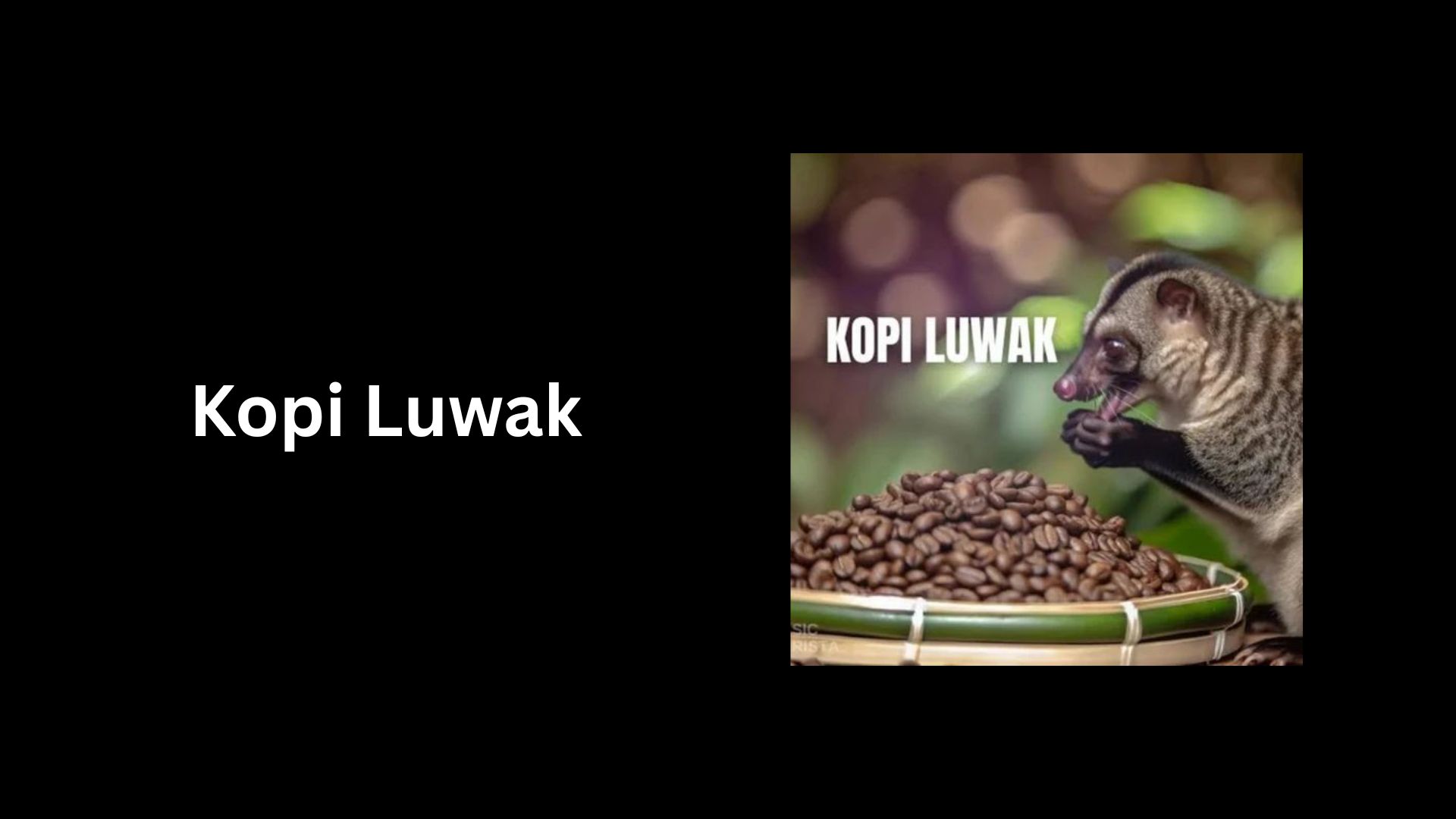
(Source: kopiluwak.org)
- Sourced from Indonesia’s Java and Sumatra islands, this coffee uses 100% wild Arabica beans, naturally processed.
- Farmers gather, wash, and sun-dry the beans to retain their unique taste.
- Typically roasted to a medium level, balancing acidity and body to highlight the coffee’s complex taste.
- Expect rich aroma, full-bodied mouthfeel, and chocolate notes.
- Acidity stays low, so each cup tastes smooth and gentle. Rarity and labour-intensive set premium prices: up to USD 600 per pound and USD 30 to 100 per cup.
- This coffee is available as whole bean, ground, Nespresso-compatible pods; enable worldwide shipping, free delivery over USD 50.
#2. Kona Coffee
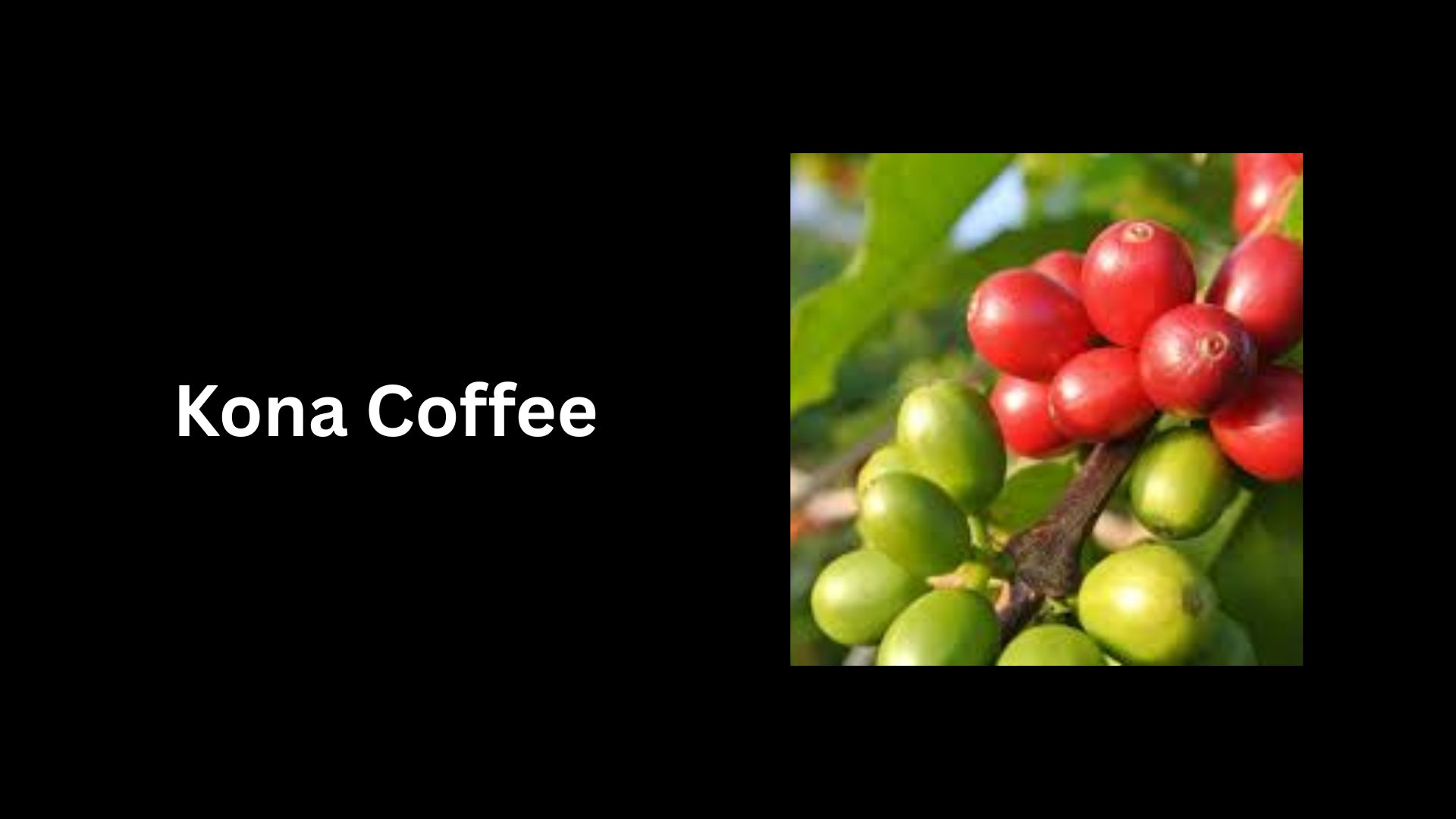
- They are grown exclusively in the North and South Kona districts of Hawaii’s Big Island.
- Primarily Guatemalan Typica, a type of Arabica coffee.
- The harvesting period starts from August to January; each tree yields approximately 15 pounds of cherries, which is equivalent to about 2 pounds of roasted coffee.
- Beans are hand-picked, pulped, fermented for 12 to 24 hours, rinsed, and sun-dried for 7 to 14 days to achieve optimal moisture levels between 9% and 12%.
- 100% Kona coffee prices vary. Some sources report costs around USD 40 per pound, while others note prices exceeding USD 60 per pound.
- In the 1987 to 88 crop year, 630 growers harvested 6 million pounds of cherries from 2,050 acres, averaging 2,900 pounds of cherries per acre.
- The Coffee Production industry in Hawaii is projected to reach a market size of USD 62.6 million by 2025, with 316 establishments and 379 employees.
- These coffees are famous for balanced flavour, medium body, bright acidity, and gently complex wine-like aroma.
#3. Blue Mountain Coffee
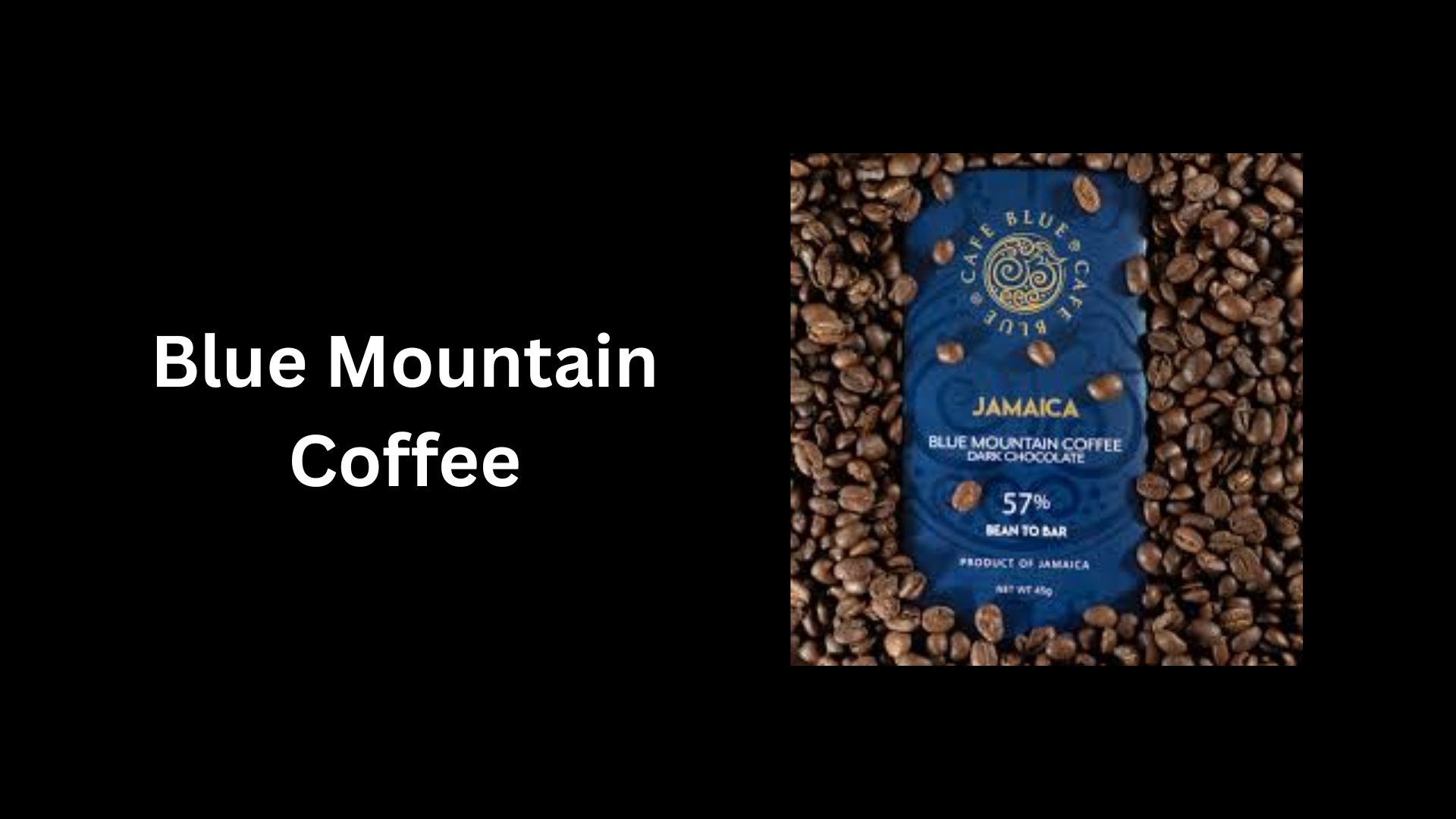
- This coffee is grown in Jamaica’s Blue Mountains, Saint Thomas, Portland, and Saint Mary and cultivated at altitudes up to 1,800 meters (5,900 feet) above sea level.
The region offers a cool, misty environment with high rainfall. - Rich, volcanic soil with excellent drainage supports healthy coffee plants.
- Bean Variety: Primarily Arabica.
- Wet-processed (washed) to enhance its clean and mild flavour profile.
- Best known for its mild flavour with a lack of bitterness, often featuring sweet, floral, and nutty notes.
- Annual production is limited, with exportable amounts varying between 400 and 1,000 metric tons.
- More than 80% of Jamaica Blue Mountain coffee goes to Japan.
- Because it is rare and high quality, prices usually fall between USD 30 and 70 per pound for buyers.
#4. Geisha Coffee
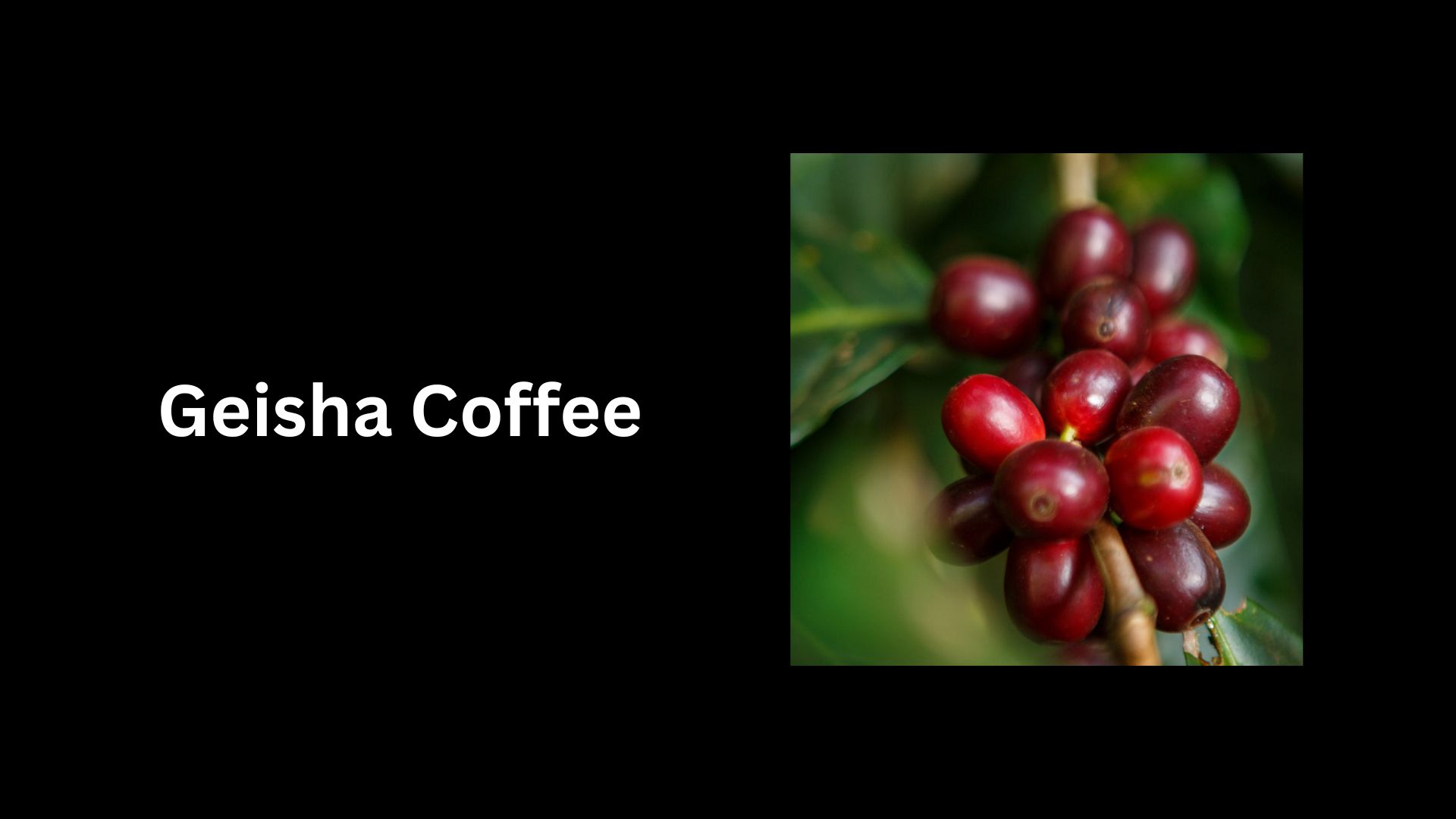
- Grown at Finca El Injerto, located in the Huehuetenango region of Guatemala.
- Cultivated at elevations ranging from 1,500 to 2,000 meters above sea level.
- Primarily, the Geisha (also spelt Gesha) variety.
- Utilises both washed and natural processing methods to enhance distinct flavour notes.
- Features tasting notes of jasmine, tangerine, stone fruit, coffee blossom, and panela sugar.
- Finca El Injerto has won the Cup of Excellence in Guatemala multiple times.
- Premium Geisha coffee can cost about USD 500 per pound.
- The farm holds Carbon Neutral and Rainforest Alliance certifications and uses eco-friendly practices.
#5. Black Ivory Coffee
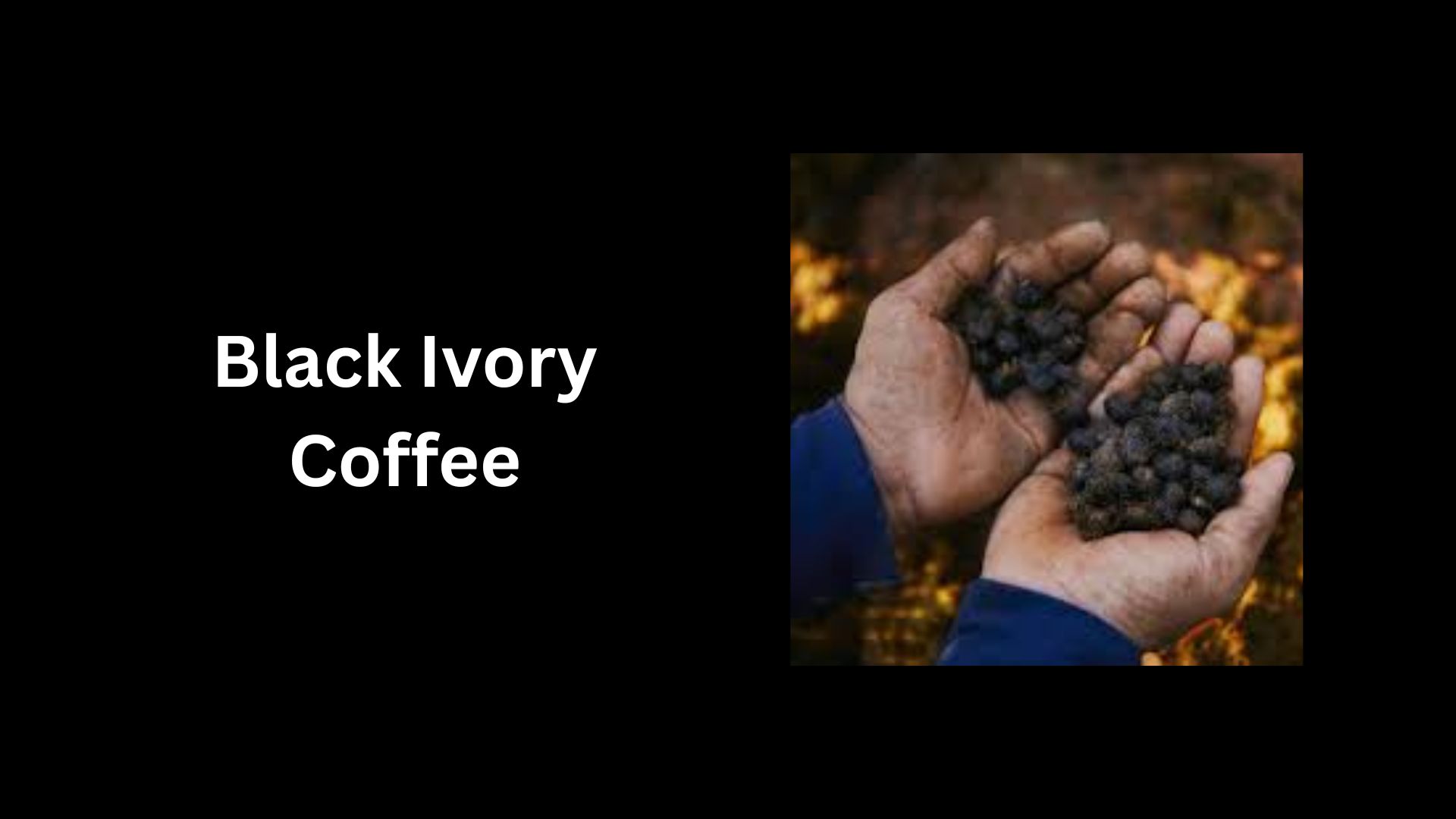
- The black ivory coffee beans undergo a fermentation process in an elephant’s digestive system for 12 to 70 hours and are then collected from their waste.
- Around 33 kilograms of coffee cherries are required to produce just 1 kilogram of Black Ivory Coffee.
- The coffee is produced in limited quantities, with about 215 kilograms produced in 2021.
- The fermentation process imparts a smooth taste with notes of chocolate, malt, spice, tamarind, and a hint of grass.
- Black Ivory Coffee is priced at approximately USD 500 per pound.
- This exclusive coffee is primarily available at select luxury hotels, resorts, and Michelin-starred restaurants worldwide.
- Black Ivory Coffee shows strong antioxidants, with more phenolics than other processed beans.
- Tests show special aromatic compounds: 2-furanmethanol and acetic acid, shaping unique flavour notes.
#6. Yemeni Coffee

- In 2024, the auction’s top lot sold for USD 1,159 per kilogram.
- The highest-rated coffee received a cupping score of 90.3 points.
- Around 36% of the auction lots were cultivated during the same period by women farmers.
- Top auction lots often have small quantities; for instance, the highest-rated lot in 2024 weighed 77 pounds.
- The 2024 auction attracted buyers from 12 countries, including significant participation from the Middle East and Asia.
- Proceeds from these auctions have significantly increased income for Yemeni coffee farmers, with some receiving over 400% above standard market prices.
- Yemen is recognised as one of the birthplaces of coffee cultivation.
- Despite facing political instability and limited rainfall (between 244 and 379 millimetres annually).
#7. Monkey Coffee
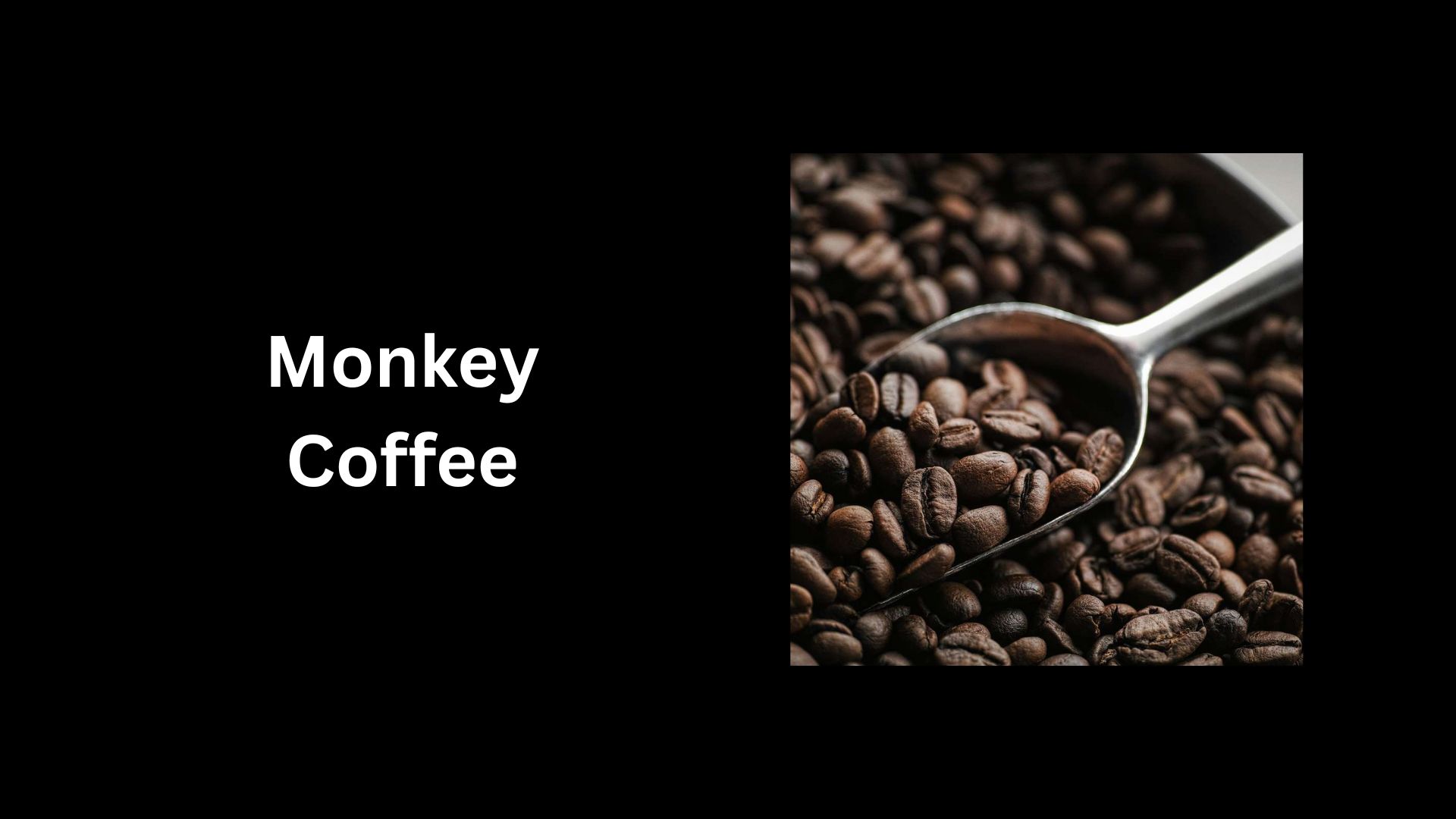
- Primary production is done in the Chikmagalur region of India and the mountainous areas of Taiwan.
- Rhesus monkeys in India and Formosan rock macaques in Taiwan.
- The enzymatic interaction from the monkeys’ saliva imparts a sweeter, less acidic taste with complex flavour notes, including vanilla, citrus, and chocolate.
- Processed beans often exhibit a greyish hue, differing from the typical green of unroasted coffee beans.
- Due to wild monkeys’ unpredictable behaviour and the labour-intensive collection process, annual production is extremely limited. Some producers harvest less than 100 pounds per year.
- The rarity and unique production method contribute to high costs, with prices ranging from USD 100 to 500 per pound.
- Farmers manually collect the chewed and spat-out beans from the forest floor.
- Unlike some other animal-processed coffees, monkeys involved in this process are wild and not captive.
#8. Bat Poop Coffee
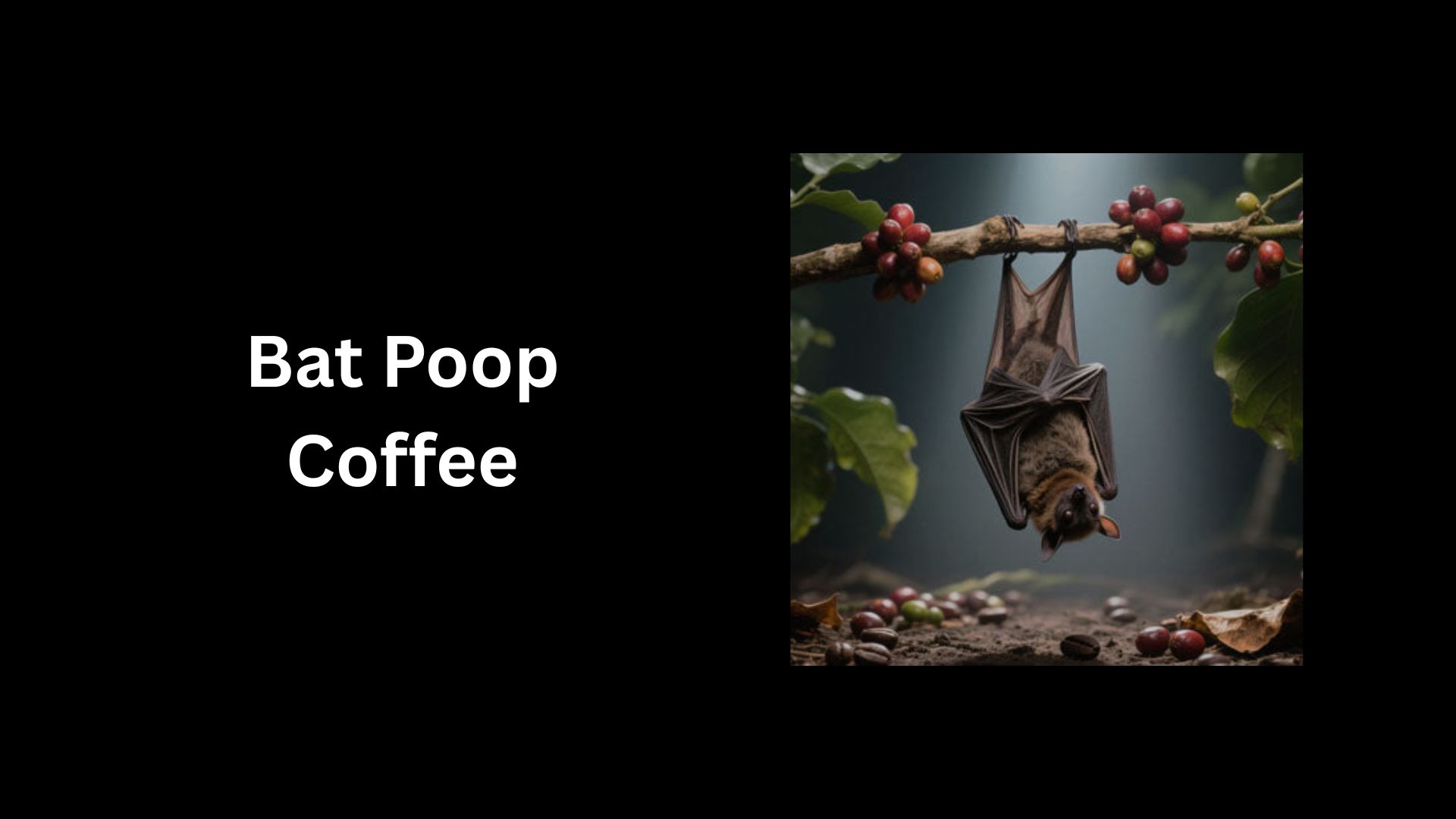
- In Madagascar, bat spit coffee, made from the Bourbon Pointu variety, sells for approximately USD 101 per pound.
- Primarily produced in Madagascar and parts of Costa Rica.
The bat’s saliva enzymes reduce the coffee’s acidity. - In Madagascar, the coffee is made from the Bourbon Pointu variety, a premium Arabica mutation known for its delicate flavour.
- Wild bats chew on ripe coffee cherries, and the partially eaten cherries are collected, processed, and roasted.
- Bat spit coffee is a rare luxury with limited supply; unlike Kopi Luwak, bats do not swallow beans.
#9. Jacu Bird Coffee

- In Brazil, Jacu birds eat ripe cherries, then farmers gather droppings, clean the beans, and start processing them.
- Mostly, they are grown at elevations between 1,250 and 1,300 meters above sea level.
- Includes Catucaia-Açu Iapar 59 and Yellow Bourbon, favoured by the Jacu birds.
- Natural processing with systematised control over temperature and humidity.
- Certified organic and biodynamic by IBD and DEMETER; quality certified by BSCA.
- Smooth flavour with striking acidity; fruity and floral aromas.
- Approximately USD 1,700 per kilogram at luxury retailers like Harrods in London.
- It accounts for under 2% of Camocim Estate’s overall coffee output.
#10. Misha Coffee

- The cost of this coffee is approximately USD 1,400 per kilogram.
- Primarily found in Bourbon Arabica, known for its high quality and rich flavour.
- Cultivated in the highlands of the Peruvian Amazon, specifically in the Chanchamayo and Satipo regions, at altitudes between 1,300 and 2,000 meters above sea level.
- Due to the meticulous and labour-intensive process, production is limited, with some sources reporting around 450 kilograms per year.
- Typically, it is medium roasted to preserve and highlight the beans’ unique flavour characteristics.
- Due to its rarity and high demand, Misha Coffee is often sold in limited quantities and may require advance orders.
Conclusion
After completing the article on the most expensive coffees in the world, it is clear that they are more than luxury beverages as they reflect hard work, skill, and the beauty of nature. Each cup of coffee shares a special story about how the beans are grown and processed with care.
These rare coffees come from unique regions and are made with patience and dedication. For coffee lovers, enjoying these expensive brews is more than tasting the flavour; it’s all about experiencing the passion, culture, and hard work of cultivators that make each sip special and truly memorable.
Sources
FAQ.
The reason behind its expensiveness is its rare beans, unique growing conditions, careful processing, and limited availability.
These coffees are made up from rare, high-quality beans grown in unique regions with careful processing.
The highest quality coffee is called Arabica, known for its smooth flavour, aroma, and rich taste.
Check aroma, flavour, acidity, body, freshness, and roast consistency to judge high coffee quality.
Rare, hand-processed coffees like Kopi Luwak and Black Ivory are the world’s most expensive types.

Maitrayee Dey has a background in Electrical Engineering and has worked in various technical roles before transitioning to writing. Specializing in technology and Artificial Intelligence, she has served as an Academic Research Analyst and Freelance Writer, particularly focusing on education and healthcare in Australia. Maitrayee's lifelong passions for writing and painting led her to pursue a full-time writing career. She is also the creator of a cooking YouTube channel, where she shares her culinary adventures. At Smartphone Thoughts, Maitrayee brings her expertise in technology to provide in-depth smartphone reviews and app-related statistics, making complex topics easy to understand for all readers.







